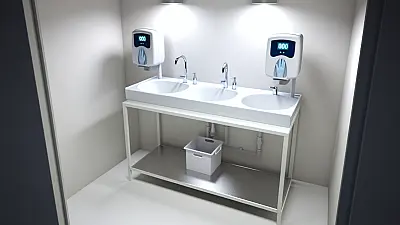WASHINGTON, IN - Inspectors at Villages at Oak Ridge documented multiple infection control violations involving staff members dragging clean laundry on floors and pressing clothing against uniforms while delivering items to resident rooms.

Improper Laundry Handling Creates Contamination Risk
During an April 1 inspection, state surveyors observed significant breaches in infection control protocols that put residents at risk of acquiring healthcare-associated infections. The violations centered on how laundry staff handled clean clothing and linens throughout the facility.
Inspectors documented laundry workers wheeling uncovered carts down hallways while clothing on hangers rubbed against walls, resident doors, and hand sanitizer dispensers. Staff members were observed taking folded items from laundry baskets and hugging them against their uniform tops while entering resident rooms to deliver the clothing.
The most concerning observation occurred when a laundry worker was seen holding resident clothing against her uniform while entering one room, then collecting additional items on hangers from the cart. The worker bent down and dragged the clothes on hangers along the floor before taking them to another resident's room.
Medical Significance of Infection Control Violations
Proper infection control in healthcare facilities serves as a critical barrier against healthcare-associated infections (HAIs), which affect approximately 1 in 31 hospital patients on any given day according to the Centers for Disease Control and Prevention. In nursing homes, where residents often have compromised immune systems and multiple chronic conditions, maintaining strict infection prevention protocols becomes even more essential.
When clean laundry comes into contact with contaminated surfaces like floors, walls, or soiled uniforms, it can become a vehicle for transmitting harmful pathogens including antibiotic-resistant bacteria such as MRSA, C. difficile, and other dangerous microorganisms. These pathogens can survive on fabric surfaces for extended periods, creating ongoing infection risks for vulnerable residents.
The documented violations represent multiple points of potential contamination. Staff uniforms accumulate pathogens throughout their shifts as workers move between different areas of the facility and interact with various residents. When clean clothing is pressed against these uniforms, cross-contamination occurs, potentially introducing infectious agents to items that will come into direct contact with residents' skin.
Industry Standards and Proper Protocols
Healthcare laundry handling follows well-established protocols designed to maintain the integrity of clean items from the laundry facility to final placement in resident rooms. Clean laundry should be transported in covered containers or carts to prevent exposure to airborne contaminants and contact with contaminated surfaces.
Clean items must be carried away from the body to prevent contamination from staff clothing, as confirmed by the facility's own policy dated December 17, 2024. This standard practice ensures that clean laundry maintains its sanitary condition until it reaches its intended destination.
The facility's Infection Preventionist acknowledged during the inspection that clean clothing should never contact staff uniform shirts and must be kept away from the body during transport. The specialist also confirmed that clean clothing should never drag along floors before delivery to resident rooms.
Professional laundry handling requires staff to use proper techniques that minimize contact points between clean items and potentially contaminated surfaces. This includes using appropriate containers, maintaining clean transportation methods, and following established protocols for item placement in resident areas.
Systemic Breakdown in Training and Oversight
The violations suggest broader issues with staff training and supervisory oversight of infection control practices. Multiple staff members were observed engaging in improper practices, indicating that the problems were not isolated incidents but rather systemic failures in protocol implementation.
Effective infection control programs require ongoing staff education, regular monitoring of compliance, and immediate correction of improper practices. The repeated nature of the observed violations suggests that these fundamental elements may have been insufficient at the time of inspection.
Healthcare facilities must maintain robust quality assurance programs that include routine auditing of laundry handling procedures. Regular competency assessments help ensure that all staff members understand and consistently apply proper infection control techniques.
Resident Vulnerability and Health Impact
Nursing home residents represent one of the most vulnerable populations in healthcare settings. Many residents have compromised immune systems due to advanced age, chronic medical conditions, or medications that suppress immune function. This vulnerability makes them particularly susceptible to healthcare-associated infections.
When infection control protocols fail, residents may develop serious complications including skin infections, respiratory illnesses, or systemic infections that can be life-threatening. Healthcare-associated infections in nursing home residents often result in prolonged illness, additional medical interventions, and in some cases, hospitalization or death.
The financial and emotional costs of preventable infections extend beyond individual residents to their families and the healthcare system. Proper infection control practices serve as essential safeguards that protect this vulnerable population from preventable harm.
Additional Issues Identified
The inspection revealed that laundry carts were not properly covered during transport, allowing airborne contaminants to settle on clean items. Staff were observed allowing clothing on hangers to make contact with various environmental surfaces including walls and doorframes during transport through hallways.
The facility's own policies clearly outlined proper procedures for handling clean laundry, indicating that appropriate protocols existed but were not being followed consistently by staff members during routine operations.
Full Inspection Report
The details above represent a summary of key findings. View the complete inspection report for Villages At Oak Ridge, The from 2025-04-02 including all violations, facility responses, and corrective action plans.
💬 Join the Discussion
Comments are moderated. Please keep discussions respectful and relevant to nursing home care quality.